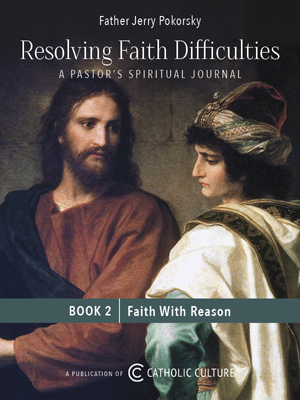Priesthood and the Masculinity of Christ
The refusal of the Catholic Church to ordain women as priests has left many feeling that the Church considers women to be inferior to men. They have difficulty reconciling the Church's proclamations of sexual equality with the 1994 papal argument of Ordinatio Sacerdotalis. In that document, John Paul II reaffirmed the 1977 teaching of Inter Insigniores and proclaims that the Church lacks the authority to ordain women, since Christ did not appoint women as apostles and since the historical tradition has restricted priestly ordination to men.
These papal arguments have not been very persuasive due to the common conviction that equality requires gender neutrality—even within the ministries of Christ. If this were so, masculinity would be irrelevant for the mission of Christ. But this is not true. The masculinity of Christ is crucial to his mission of remedying the effects of original sin.
According to Genesis, original sin deprived the human race of its original unity with God and deeply affected the original unity of man and woman. As a result, Christ had an humanitarian mission to restore unity with God and a gender mission to restore heterosexual unity. The humanitarian mission required that Christ be fully human and fully God. Accordingly, since women are as human as men, God could have incarnated as a woman. A female Christ could have restored the human race to its original unity with God. It is not Christ's humanitarian mission that required Christ to be male.
The maleness of Christ is required to restore the unity between men and women disrupted by original sin. Genesis 3:16 says, "Your desire will be for your husband, and he will rule over you." This passage indicates three gender consequences of original sin: the excessive desire or obsession of women for their men, male domination over women and sexual inequality. Freeing the human race from these consequences of original sin constitute Christ's gender mission.
These consequences are significant. In his letter On the Dignity and Vocation of Women, John Paul II identifies male domination with chauvinism and blames it for the many ways in which women suffer from the lack of proper appreciation for her equality and dignity. Chauvinism—as a consequence of Original sin—required that the Christ be a man. Due to chauvinism, a female Christ would not have been recognized by men as being their lord, their rabbi, their savior. Christ exemplified sacrificial love, which chauvinism identifies as a weakness and as a peculiarity of women. According to chauvinism, maleness is about power, independence, and control. Not so, taught Christ. Rather, masculinity is for the sake of pouring out one's life for another in love, not for the sake of dominating self-gratification.
Fallen women also needed Christ to be incarnated as a man-and not only to teach men a lesson. Original sin weakened femininity to the point where it blinded women to the truth about her desire for love. Original sin derailed woman's transcendent passion for God with an egocentric passion for man-for a Mr. Right able to satisfy the yearnings of her heart. Fallen woman thus assumes either that Mr. Right will be perfect or that accommodating his chauvinism will be the sacrifice that enables her to be loved. Thus, woman needs not only to be freed from the harms of chauvinism but also from the misdirection of her desire. Women need to learn not only that there can only be one perfect man, Jesus Christ, but also that men need not be chauvinistic. If Christ had been incarnated as a woman, these lessons would have been untaught. Thus, the gender mission of Christ required Christ to be incarnated as a man for the sake of women as well as for the sake of men.
If Christ had to be incarnated as a man in order to fulfill his gender mission, then it is not possible for women to undertake this mission. If it is not possible for women to undertake the gender mission, then it is not possible for women to be ordained Catholic priests. For the Catholic priest images Christ in his gender mission as well as in his humanitarian mission. This is particularly the case since the Catholic Church was founded to counter the effects of Original Sin.
Since the refusal of the Catholic Church to ordain women is grounded on the gender mission of Christ, it is a refusal that promotes sexual equality. It is incredibly important that the Church promote sexual equality—for two reasons. First, sexual equality counters the harmful gender inequities of original sin. Secondly, as John Paul II points out, it is only when spouses recognize and appreciate the equality of the other that they are able to appreciate properly the other's spousal gift of self. Without this appreciation, marriages fail to properly image the loving equality of the Trinity. Genesis 1:27 says "God created man in his own image, in the image of God he created him; male and female he created him." We are made in the image of God. Thus, we love best when we love as God loves. As John Paul II puts it in On the Dignity and Vocation of Women, n.7:
"The fact that man 'created as man and woman' is the image of God means not only that each of them individually is like God, as a rational and free being. It also means that man and woman, created as a 'unity of the two' in their common humanity, are called to live in a communion of love, and in this way to mirror in the world the communion of love that is in God, through which the Three Persons love each other in the intimate mystery of the one divine life."
In other words, heterosexual love and spousal oneness image the love and the oneness of the Trinity, where the distinction of persons—and roles—precludes neither unity or equality. Thus, the need to image Trinitarian love requires heterosexual equality. The Church is thereby obligated to promote sexual equality.
Therefore, the promotion of sexual equality, Trinitarian love, and faithfulness to the missions of Christ requires the Catholic Church to forgo ordaining women. By so doing, not only does she proclaim the importance of Christ's male incarnation and the need for ordained priests to image His gender mission, but she also honors her Savior.
August 16, 2004
@Copyright, R. Mary Hayden Lemmons. All rights reserved. For a more complete argument, please see the author’s article in Logos: A Journal of Catholic Thought and Culture, entitled "Equality, Gender, and John Paul II," Logos 5:3 (Summer 2002): 111-130.
This item 6586 digitally provided courtesy of CatholicCulture.org






